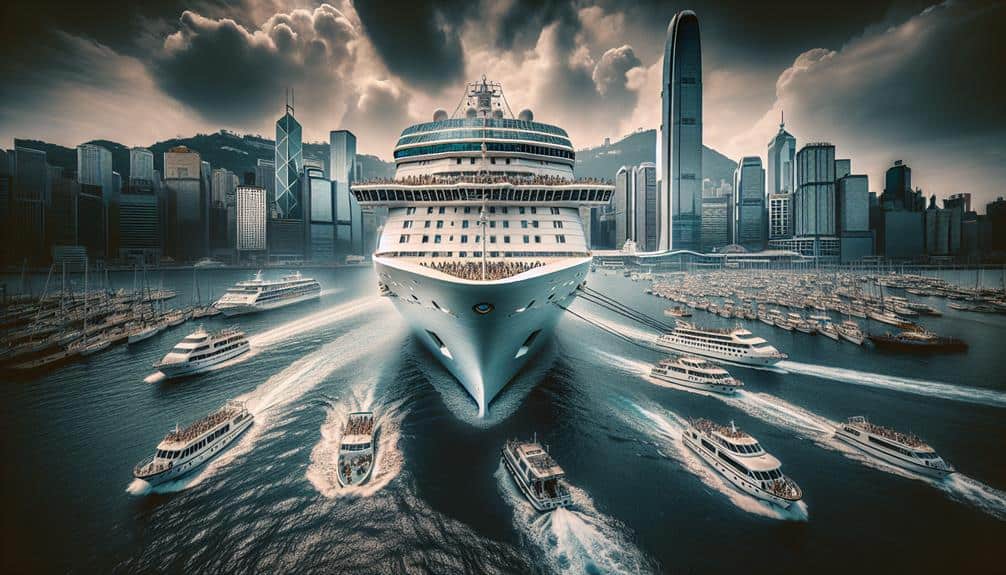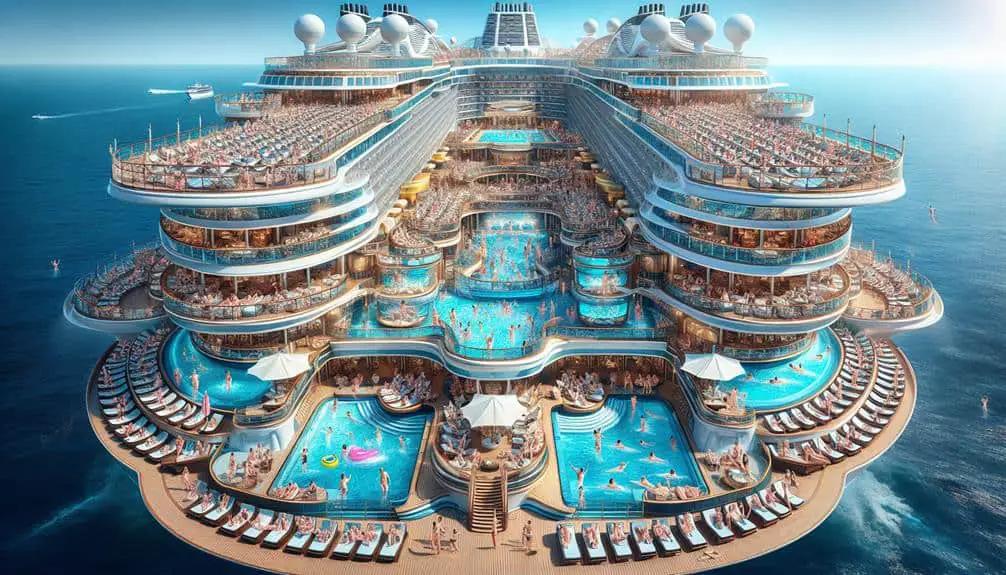When considering the ideal cruise ship size, focus on passenger satisfaction, amenities, economies of scale, and striking a balance between entertainment options and a personalized experience. Small ships offer intimacy and tailored service, while medium-sized vessels provide a cozy feel with diverse onboard facilities. Larger liners boast a wide array of amenities but require crowd control measures. Factors like space limitations, personalized service, and chosen experience all influence the decision. The size impacts onboard ambiance, amenities, and overall satisfaction. Each ship size has distinct advantages, so finding the right fit depends on your preferences and priorities.
Key Points
- Consider passenger preferences for intimate or diverse experiences.
- Evaluate ship size based on desired amenities and personalized service.
- Balance space limitations with passenger comfort and onboard facilities.
- Optimize ship capacity for efficient operations and crowd control.
- Prioritize safety measures and emergency procedures for larger vessels.
Benefits of Small Cruise Ships
Small cruise ships offer a more intimate experience and personalized service compared to larger vessels, allowing passengers to enjoy a closer connection with the destinations they visit. The smaller size of these ships creates a sense of exclusivity, fostering a strong community feel among passengers and crew. With fewer guests onboard, the staff-to-guest ratio is often higher on small cruise ships, enabling a more attentive and tailored service. This personalized approach extends to activities and excursions, where individual preferences can be accommodated more easily.
Moreover, the intimate experience on small cruise ships allows for a deeper immersion in the local culture and environment. Passengers have the opportunity to explore off-the-beaten-path destinations that larger ships can't access, enhancing the sense of discovery and adventure. The intimate setting also encourages meaningful interactions among passengers, fostering new friendships and creating lasting memories. Overall, the personalized service and intimate atmosphere of small cruise ships offer a unique and enriching travel experience.
Advantages of Medium-Sized Vessels
Medium-sized vessels provide a balance between the intimacy of small cruise ships and the amenities of larger vessels, offering passengers a unique cruising experience that combines personalized service with a broader range of onboard facilities and activities. These ships typically accommodate between 500 to 2000 passengers, creating a more intimate atmosphere than larger liners while still providing a variety of entertainment options and dining choices.
One advantage of medium-sized vessels is the opportunity for personalized experiences. With fewer passengers on board compared to larger ships, guests can often receive more tailored attention from the crew, leading to a more customized and attentive service throughout the cruise. Additionally, the cozy atmosphere encourages a sense of community among passengers, allowing for more meaningful interactions and connections during the voyage.
Furthermore, medium-sized vessels often showcase a diverse range of onboard facilities, including multiple dining venues, entertainment options such as theaters and casinos, spa facilities, and recreational activities like pools and fitness centers. This variety guarantees that passengers have a wide selection of experiences to choose from, catering to different preferences and interests.
Considerations for Large Cruise Liners
When considering large cruise liners, it's essential to analyze their capacity, amenities, and operational efficiency to guarantee a seamless and enjoyable cruising experience. Large cruise ships offer a wide array of amenities to enhance passenger experience, such as multiple dining options, entertainment venues, spas, and recreational facilities. However, the challenge lies in effectively managing the large number of passengers onboard to avoid overcrowding and ensure smooth operations. To address this, cruise lines implement sophisticated crowd control measures, including staggered dining times, reservation systems for onboard activities, and strategic layout designs to disperse crowds effectively.
Efficiency is paramount on large cruise liners to prevent delays and provide a high level of service. Advanced technologies like RFID-enabled wristbands for onboard purchases and streamlined boarding processes play a critical role in optimizing operational efficiency. In addition, these ships must prioritize safety and emergency procedures, considering the larger number of passengers they accommodate. By carefully balancing amenities, crowd control strategies, and operational efficiency, large cruise liners can deliver an excellent cruising experience for their guests.
Factors to Determine the Best Size
Analyzing key factors is essential in determining the best size for a cruise ship. When considering space limitations, it's important to balance the number of passengers a ship can accommodate with the comfort and amenities it can offer. Larger ships may provide a wider range of activities and dining options but could lead to overcrowding and longer wait times. On the other hand, smaller ships can offer a more intimate experience with personalized service and fewer crowds, but they might've fewer entertainment choices.
Moreover, the ideal size of a cruise ship also depends on the type of experience passengers are seeking. Some travelers prefer the excitement and variety that come with larger vessels, while others prioritize a quieter, more exclusive atmosphere.
Choosing the Right Ship Capacity
To optimize the cruise experience, selecting the appropriate ship capacity is a strategic decision that directly impacts passenger satisfaction and onboard amenities. When considering ship capacity, it's important to balance passenger experience with available space. A higher capacity ship may offer more onboard amenities and activities due to economies of scale, but this might result in crowded common areas and longer wait times. On the other hand, a smaller capacity ship provides a more intimate setting with fewer passengers, allowing for a more personalized experience and easier access to amenities.
Passenger experience is greatly influenced by the ship's capacity as it determines the level of intimacy and comfort onboard. A ship with a lower capacity often translates to more space per passenger, enhancing the overall experience. Additionally, amenities such as pools, restaurants, and entertainment venues can be more easily enjoyed without feeling overcrowded. Ultimately, choosing the right ship capacity requires a careful evaluation of the desired passenger experience, space availability, and onboard amenities to guarantee a satisfying cruise journey.
Frequently Asked Questions
Can Smaller Cruise Ships Offer the Same Level of Amenities and Entertainment Options as Larger Vessels?
Smaller cruise ships can match larger vessels in amenities and entertainment by offering intimate experiences, varied dining options, and innovative onboard activities. Despite smaller passenger capacities, they excel in personalized service, spacious cabin sizes, and unique experiences.
How Do Cruise Ship Sizes Affect the Overall Passenger Experience and Sense of Community on Board?
In considering cruise ship sizes, passenger interactions and onboard activities are influenced heavily. The sense of community thrives on smaller vessels, facilitating more intimate connections among guests. Larger ships offer a vast array of activities, catering to diverse preferences.
Are There Any Safety Concerns or Advantages Associated With Different Sizes of Cruise Ships?
When considering safety concerns and passenger experience on cruise ships, varying sizes play an important role. Larger ships may offer more amenities but could pose challenges during emergencies. Smaller ships can provide a more intimate experience but may have limited safety features.
Do Smaller Cruise Ships Have Different Itineraries or Destinations Compared to Larger Ships?
When considering smaller ship flexibility, you'll find they often navigate unique destinations inaccessible to larger vessels. These ships can dock in smaller ports, offering a more intimate and exclusive experience for travelers seeking off-the-beaten-path adventures.
How Do Cruise Ship Sizes Impact Environmental Sustainability and Carbon Emissions?
When contemplating cruise ship sizes, it is crucial to recognize their influence on environmental sustainability and carbon emissions. Larger ships generally have greater carbon footprints because of heightened energy consumption for propulsion, amenities, and onboard operations.




